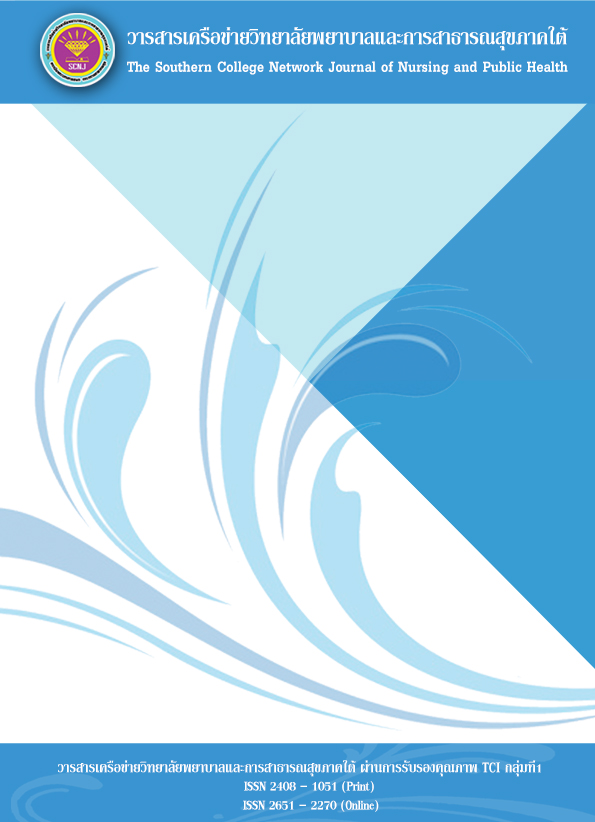ความสัมพันธ์ระหว่างปัจจัยสิ่งแวดล้อมทางสังคมกับการดื่มเครื่องดื่มที่มีแอลกอฮอล์ของวัยรุ่น
คำสำคัญ:
ปัจจัยสิ่งแวดล้อมทางสังคม, การดื่มเครื่องดื่มที่มีแอลกอฮอล์, วัยรุ่นบทคัดย่อ
การวิจัยเชิงวิเคราะห์ ณ จุดวเลาใดเวลาหนึ่ง (Cross-Sectional Analytic Study) มีวัตถุประสงค์เพื่อศึกษาความสัมพันธ์ระหว่างปัจจัยสิ่งแวดล้อมทางสังคมกับการดื่มเครื่องดื่มที่มีแอลกอฮอล์ของวัยรุ่น กลุ่มตัวอย่างคือนิสิตมหาวิทยาลัยมหาสารคาม จำนวน 360 คน ดำเนินการสุ่มตัวอย่างแบบชั้นภูมิ เก็บรวบรวมข้อมูลโดยใช้แบบสัมภาษณ์ ได้ค่าสัมประสิทธิ์อัลฟาของครอนบาค เท่ากับ 0.80 สถิติที่ใช้ได้แก่ ร้อยละ ค่าเฉลี่ย และ Binary Logistic Regression โดยควบคุมตัวแปร เพศ, อายุ, เงินค่าใช้จ่ายที่ได้รับต่อเดือน การดื่มเครื่องดื่มที่มีแอลกอฮอล์ของสมาชิกในครอบครัวและเพื่อน, การยอมรับการดื่มเครื่องดื่มที่มีแอลกอฮอล์ของเพื่อน, การอนุญาตให้ดื่มเครื่องดื่มที่มีแอลกอฮอล์ของพ่อแม่ และการสั่งสอนของพ่อแม่เกี่ยวกับเครื่องดื่มที่มีแอลกอฮอล์ ผลการวิจัยพบว่า
ส่วนใหญ่เป็นเพศหญิง (ร้อยละ 51.67) มีอายุเฉลี่ย 19.63 ปี มีคนดื่มเครื่องดื่มที่มีแอลกอฮอล์ ร้อยละ 52.22 มีสมาชิกในครอบครัวและเพื่อนดื่มเครื่องดื่มที่มีแอลกอฮอล์ (ร้อยละ 65.00 และร้อยละ 74.72 ตามลำดับ) เพื่อนยอมรับการดื่ม (ร้อยละ72.50) พ่อแม่อนุญาตให้ดื่ม (ร้อยละ 65.83) มีค่านิยมของสังคมเกี่ยวกับอันตรายจากการดื่มเครื่องดื่มที่มีแอลกอฮอล์ในระดับสูง (ร้อยละ 49.44) และสามารถเข้าถึงเครื่องดื่มที่มีแอลกอฮอล์ได้ง่าย (ร้อยละ 72.78) จากการวิเคราะห์ความสัมพันธ์ระหว่างปัจจัยสิ่งแวดล้อมทางสังคมกับการดื่มเครื่องดื่มที่มีแอลกอฮอล์ เมื่อควบคุมตัวแปรกวน พบว่า การมีคะแนนค่านิยมของสังคมเกี่ยวกับอันตรายจากการดื่มเครื่องดื่มที่มีแอลกอฮอล์ในระดับสูง ทำให้โอกาสของการดื่มเครื่องดื่มที่มีแอลกอฮอล์ลดลงอย่างมีนัยสำคัญทางสถิติ (aOR =0.52, 95%CI: 0.30-0.87) ส่วนการเข้าถึงเครื่องดื่มที่มีแอลกอฮอล์ได้ง่าย จะเพิ่มโอกาสเสี่ยงของการดื่มเครื่องดื่มที่มีแอลกอฮอล์อย่างมีนัยสำคัญทางสถิติ (aOR=2.09, 95%CI: 1.16-3.77)
ดังนั้น ควรกำหนดมาตรการด้านสิ่งแวดล้อมทางสังคมควบคู่กับมาตรการอื่น ๆ เพื่อให้เกิดการปรับเปลี่ยนพฤติกรรมสุขภาพของบุคคลร่วมกัน
References
Bronfenbrenner, U. (1994). Ecological Models of Human Development. IntEncyclEduc, 3(2), 1643-1647.
Bryden, A., Roberts, B., McKee, M., & Petticrew, M. (2012). A Systematic Review of the Influence on Alcohol Use of Community Level Availability and Marketing of Alcohol. Health Place, 18(2), 349-357.
Bryden, A., Roberts, B., Petticrew, M., & McKee, M. (2013). A Systematic Review of the Influence of Community Level Social Factors on Alcohol Use. Health Place, 21, 70-85.
Chawla, N., Neighbors, C., Logan, D., Lewis, M. A., & Fossos, N. (2009). Perceived Approval of Friends and Parents as Mediators of the Relationship Between Self-Determination and Drinking. J Stud Alcohol Drugs, 70(1), 92-100.
Chirawatkul, A., Laopaiboon, M., Jeeraporn, K., Thavornpitak, Y., Chokkanatitak, J., Thinkhamrop, B, et al. (2004). Biostatistics for Health Science Research. Khon Kaen: Department of Biostatistics and Demography, Faculty of Public Health, Khon Kaen University, Khon Kaen. (in Thai).
DeHaan, L., & Boljevac, T. (2010). Alcohol Prevalence and Attitudes among Adults and Adolescents: Their Relation to Early Adolescent Alcohol Use in Rural Communities. J Child Adolesc Subst Abuse, 19(3), 223–243.
Duncan, S. C., Duncan, T. E., & Strycker, L. A. (2002). A Multilevel Analysis of Neighborhood Context and Youth Alcohol and Drug Problems. Prev Sci, 3(2), 125-133.
Fergusson, D. & Boden, J. (2017). Alcohol Use in Adolescence. Retrieved October 12, 2017 from https://www.otago.ac.nz/christchurch/otago018747.pdf
Foo, Y. C., Tam, C. L., & Lee, T. H. (2012). Family Factors and Peer Influence in Drug Abuse: a Study in Rehabilitation Centre. Int J Collab Res Intern Med Public Health, 4(3), 190-201.
Galea, S., Nandi, A., & Vlahov, D. (2004). The Social Epidemiology of Substance Use. Epidemiol Rev, 26(1), 36-52.
Gibson, C. (2014). Peer and Neighborhood Influences on Substance Use among Emerging adult Males: An Activity Spaces Approach. A Thesis in Partial for the Master of Public Health, School of Public Health, Yale University.
Hasin, D., & Keyes, K. (2011). The Epidemiology of Alcohol and Drug Disorders. Addiction Medicine: Science and Practice. Switzerland: Springer Nature, pp 23-49.
Kitchua, R., Tenitsara, K., Thirasilawe, T., & Kanasri, S. (2012). Alcohol Consumption Behaviors, Drinking Impacts and Quality of Life in Mahasarakham University Students. A Thesis in Partial Fulfillment of the Requirement for the Doctor of Pharmacy, Faculty of Pharmacy, Mahasarakham University. (in Thai)
Krohn, M. D., Lanza-Kaduce, L., & Akers, R. L. (1985). Community Context and Theories of Deviant Behavior: An Examination of Social Learning and Social Bonding Theories. The Sociological Quarterly, 25,353–371.
Kulsawat, T. (2015). Quality Testing of Tests. Chon Buri: Faculty of Political Science and Law, Burapha University, Chon Buri. (in Thai).
Lekfuangfu, N., Thanphanit, N., Thacharoen, K., Vongvaisririwat, S., & Withworaphong, N. (2015). Situation of Alcohol Consumption in Norteast, Thailand. Bangkok: National Statistical Office, Bangkok. (in Thai)
Nakphan, U. (2014). Alcohol Consumption and Learning Performance of College Students: An Econometrics Approach. NIDA Economic Review, 8(1), 73-117. (in Thai)
Osei-Bonsu, E., Appia, P. K., Norman, I. D., Asalu, G. A., Kweku, M., Ahiabo, S. Y. et al. (2017). Prevalence of Alcohol Consumption and Factors Influencing Alcohol Use among the Youth in Tokorni-Hohoe, Volta Region of Ghana. Science Journal of Public Health, 5(3), 205-214.
Petronyte, G., Zaborskis, A., & Veryga, A. (2007). Risk Factors for Alcohol use among Youth and Main Aspects of Prevention Programs. Medicina (Kaunas), 43(2), 103-109.
Pettigrew, S., & Donovan, R. (2003). A Literature Review of the Factors that Influence Alcohol Consumption and the Effectiveness of Past Interventions. Perth, Western Australia: Centre for Behavioural Research in Cancer Control.
Posri, K., Chumnanborirak, P., Singhkum, B., Kraichan, K., Raiviboon, S., & Singhkum, S. (2015). The Situation of Consumption and Policy in Preventing Alcohol in Mahasarakham. Phitsanulok: Naresuan Research Conference, Naresuan University, Phitsanulok. (in Thai)
Saengow, U., Vichitkunakron, P., & Assanangkornchai, S. (2016). Facts and Figures: Alcohol in Thailand. Songkhla: Prince of Songkla University, Songkhla. (in Thai)
Scribner, R., Theall, K. P., Simonsen, N., & Robinson, W. (2010). HIV Risk and the Alcohol Environment. Alcohol Research & Health, 33(3), 179-183.
Sudhinaraset, M., Wigglesworth, C., & Takeuchi, D. T. (2016). Social and Cultural Contexts of Alcohol Use: Influences in a Social–Ecological Framework. Alcohol Res, 38(1), 35–45.
Tucker, J. S., Pollard, M. S., de la Haye, K., Kennedy, D. P., & Green, H. D Jr. (2013). Neighborhood Characteristics and the Initiation of Marijuana Use and Binge Drinking. Drug Alcohol Depend, 128(1-2), 83-89.
Vantamay, S. (2009). Alcohol Consumption among University Students: Applying a Social Ecological Approach for Multi-Level Preventions. Southeast Asian J Trop Med Public Health, 40(2), 354-369.
Waleewong, O., Chaiyasong, S., & Thamarangsi, T. (2010). Influence of Parental Norms and Behaviours on Youth Drinking in Thailand. Bangkok: Center for Alcohol Studies, Bangkok. (in Thai)
Downloads
เผยแพร่แล้ว
ฉบับ
บท
License
1. บทความหรือข้อคิดเห็นใด ๆ ที่ปรากฏในวารสารเครือข่าย วิทยาลัยพยาบาลและการสาธารณสุขภาคใต้ ที่เป็นวรรณกรรมของผู้เขียน บรรณาธิการหรือเครือข่ายวิทยาลัยพยาบาลและวิทยาลัยการสาธารณสุขภาคใต้ ไม่จำเป็นต้องเห็นด้วย
2. บทความที่ได้รับการตีพิมพ์ถือเป็นลิขสิทธิ์ของ วารสารเครือข่ายวิทยาลัยพยาบาลและการสาธารณสุขภาคใต้







